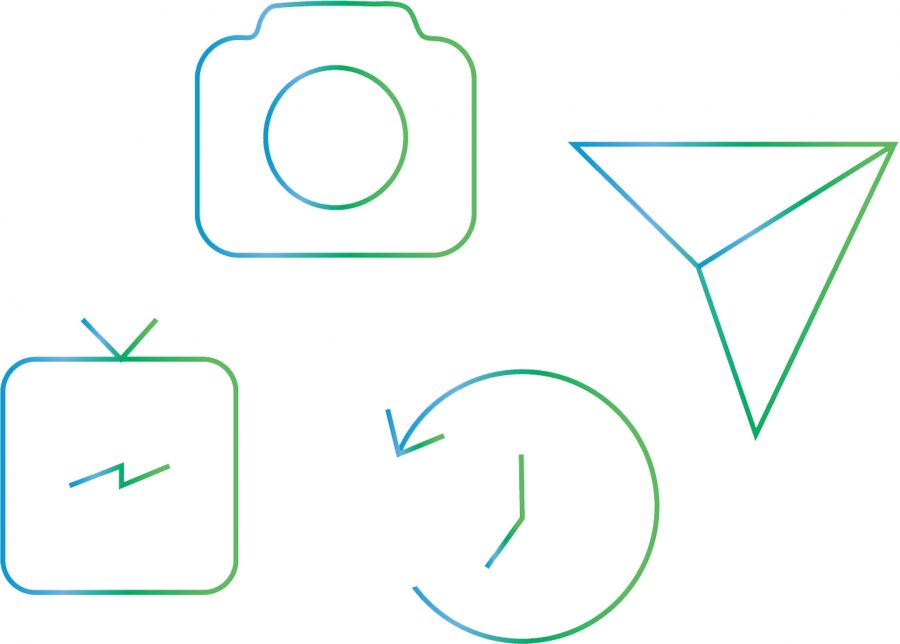During her seventh grade class, sophomore Lydia Olmsted received an assignment her teacher explicitly referred to as the “dumb kid” worksheet. The teacher wasn’t confident in Olmsted’s abilities, not because she was behind in math or any of her classmates, but because Olmsted was born blind.
“When she gave [the worksheet] to me, I was quite speechless because it seemed quite uncalled for,” Olmsted said. “But then that also motivated me; just from that anger of that event, it motivated me to kind of tell her that [I am more capable than that], and [I felt] hurt that she gave me that worksheet.”
Occurrences similar to the “dumb kid” worksheet happened often for Olmsted, especially in elementary and middle school when students and teachers didn’t understand her situation. Olmsted cannot see colors or any distinct, detailed figures, but she is able to see light and the shapes of objects blocking the light. She walks with her cane, relying on it by touch and using sound to navigate the busy halls of RBHS.
“I don’t necessarily see myself being overly different, but it can be a little bit interesting in a way because a lot of people are not sure how to interact with me, or they are kind of afraid to,” Olmsted said. “That can be interesting with the cane; a lot of people get kind of freaked out when they see it. It can be kind of challenging navigating with it, but I think I do pretty well with it.”
-
Only two to eight percent of visually impaired people use a cane. The rest use a seeing-eye dog, sighted guide or usable vision
-
– Many modern canes only weigh up to seven ounces
-
– In some states, if a person who is not visually impaired is caught using a cane to gain the right of way, they can face a heavy fine
When Olmsted reaches her destination, she often takes a seat with her paraprofessional, an aid that helps her interpret classroom activities such as describing images and videos or describing what’s on the board to her. As for worksheets, Olmsted utilizes braille and electronic formats in order to get her work done quickly and efficiently. Olmsted, however, is not alone in her unique high school experience. Approximately 62,528 students under the age of 21 are visually impaired according to a study by National Federation of the Blind, with 8.2 percent of that population using braille to read in class, like Olmsted.
“I feel like a lot of my teachers, especially in high school, have been really helpful,” Olmsted said. “I know sometimes not everyone gets along and understands what I need, but I feel like most of them have really gone above and beyond to help me. I think overall the classroom environment is pretty good for me.”
Olmsted experiences classes as any other sophomore would along with help from her paraprofessional and technological help. Junior Daniel Schroeder, however, remembers his brother, Matthew Schroeder, to have a different educational experience as he was born with Down syndrome. Matthew Schroeder was one out of 700 babies each year according to statistics from the National Down Syndrome Society (NDSS). Though Daniel Schroeder said his life diverges from his brother’s only because they will take different paths when out of school.
“While I come home with textbooks, essays and worksheets to do, he hasn’t had a lot of homework as of late,” Schroeder said. “He works jobs as part of the special education class at [RBHS], cleaning tables at Shakespeare’s, for instance. Once we get out of school, I’m off to college while he stays at home, holding down the fort.”
As the Schroeders begin thinking about their future as they wrap up junior year, Daniel Schroeder is unsure of what his brother’s life will entail. They will graduate at the same time since they are in the same grade yet one year apart in age. Matthew Schroeder will stay at home with his mother and father, Daniel Schroeher said, but the legal process for their parents to keep custody of Matthew Schroeder is complicated. In order to keep custody, Matthew Schroeder’s parents could seek the route of guardianship, which is just one of many other alternatives. Guardianship can give parents the ability to make decisions for their child’s healthcare, housing, money and property depending on which type of guardianship they seek. These legal decisions and discussions among the family often come during the transition out of school friendshipcircle.org reported. As for now, Matthew Schroeder plans to become a rapper or a movie star when he gets out of school.
“Before [the legal decisions] happen, I think Matthew and I will continue to do what we do: playing video games together, listening to music, watching movies,” Daniel Schroeder said. “I think the most common misconception is that a person with a disability is different from anyone else. Sure, there are hurdles to jump through sometimes, and disabilities require more [obstacles] than others, but a person with a disability is just like anyone else.”
“
I think the most common misconception is that a person with a disability is different from anyone else. Sure, there are hurdles to jump through sometimes, and disabilities require more [obstacles] than others, but a person with a disability is just like anyone else.” – Daniel Schroeder, junior
Schroeder’s point of his brother being no different than anyone else is not uncommon. In a blog on theguardian.com, a student publicized his campaign, “Don’t call me special,” in order to express disagreement with calling students with disabilities “special.” Likewise, Columbia Public Schools transition coordinator Caryl Smarr recognizes all students as students, regardless of special needs.
“All individuals have strengths and weaknesses, and this is true with any high school student. Our hope for all students is a successful and purposeful transition after high school, be that attending college, receiving vocational training, employment, supported employment or volunteer work,” Smarr said. “With the exception of an area of educational weakness that has been identified as needing support and/or services, students receiving special education services are no different than any other student, and our hopes and expectations for their future are no different from any educator.”
Olmsted also doesn’t recognize herself as different from anyone else and makes a point to show people who doubt her that she is capable of doing anything others can do despite her visual impairment. Her goal is to be treated as any other person and for people to not see her as “the blind girl.” Olmsted, who wears her ‘keep calm, it’s just a cane’ sweatshirt proudly, loves animals and arts and crafts, as well as playing and listening to baseball, horseback riding and baking sugar cookies, which she has a really good recipe for. For the future, Olmsted wants to have a family and a seeing-eye dog, and she plans to have a career in marine biology, journalism or maybe even law or legislation.
“I think, at least, my hope is that [my blindness] will be more of a positive impact [on my future] because I’m hoping that I can be able to use that to kind of help others better understand those with disabilities,” Olmsted said. “I just hope in the career areas that it will kind of help and have a variation of people, and I’m hoping that my visual impairment will have a unique perspective on whatever field it is that I go into. I want to show people that I’m capable of all of the things that they are able to do.”





















































































